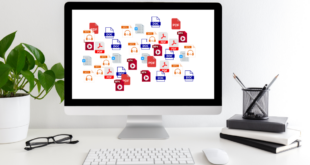Once upon a time, working from home was offered as a perk to help the overworked and burned-out employees. After the pandemic hit last year, this appealing perk became the norm for most businesses.
This work setup has been both rewarding and challenging for the employers, the HR department, and the employees. How to manage a remote team has become the latest query of the HR department and team managers, and it’s your responsibility to set up a clear path for your team’s success.
Success can only be achieved with the right tools. Here are some of the top tools you need to manage your teams working from home:
Communication Tools
Effective communication is the bedrock of any workforce. However, for remote teams, it can be challenging, especially with the location-distributed team. If your team can’t talk to others, people will step on each other’s toes or lose teamwork altogether.

-
Slack
Slack is one of the most popular communication management software available. It helps simplify all company communication into one place. You can create specific team channels for every department to send direct messages.
It can also act as a virtual cooler, allowing team members to bond and gather together for both team-building and professional purposes. Plus, you’ll love the fun emojis.
-
Zoom
You’re probably using Zoom already, but if you’re not, then you’re missing a lot on remote communications. Zoom is the most popular video conferencing software for connecting and communicating with numerous people from your team.
Combining HD video with essential features like content sharing, local recording, and screen sharing made it an obvious choice for businesses in need of a reliable end-to-end conferencing and communication solution.
Workforce Data Analytics And Management
A workforce isn’t easy to manage and track. With numerous cogs working at different paces, you might struggle to stay on top of task scheduling or obtaining data for HR management and practices. To increase HR productivity, here are a couple of tools to help:

-
Revelio
Reveliolabs calls itself a workforce intelligence company. It’s the world’s first universal HR database and it helps you understand your company’s workforce dynamics and focuses on providing actionable insights into your workforce data.
It uses millions of public employment records to predict your company’s internal movements, career transitions, hiring and attrition trends, geographic composition, and more. Likewise, it can help offer different trends in your workforce data, providing methods for driving performance and productivity.
-
Datis
Datis connects your HR smoothly with other workforce management considerations. So, if your company has several departments, this software can connect them together and provide an overall picture. This prevents silos of disconnected employees.
In addition, Datis can help manage your workforce from recruitment to the entire employee cycle. Plus, it can integrate with your existing payroll system, which is a critical part of any workforce management.
Task Management
Assigning tasks and follow-ups can be difficult if your team is working at different locations. Everyone can use a little help to stay on top of work assignments and priority tasks. With the proper tools, your team won’t be running in circles and missing important deadlines.

-
Monday
Monday is perhaps one of the most reliable and powerful projects management platforms you can find. It has advanced features that can help remote teams to manage, track, and execute various initiatives and tasks in real-time.
Combining intuitive UI and automation capabilities, Monday is also user-friendly, helping the workers who aren’t tech-savvy. Also, this software can integrate with numerous business tools, which is a must-have for every modern team.
-
Trello
Trello allows your team and every department to design, create, assign, and manage tasks in a straightforward visual interface. What makes it different from Monday is you can create virtual cards for each task and sort them by assignee, department, or team.
As the task progresses, team members and employees can slide the relevant task card from one category to the next. Its collaborative tool also allows your team to stay informed on the various task progress.
Productivity And Reporting
Productivity can instantly go out of the window with the numerous distractions offered by a home environment. These time-tracking tools should help:

-
Time Doctor
If you need software that can monitor how your employees are spending time, then Time Doctor is a must-try.
With this, you can create tasks and run the clock when working. It can also show a summary of the hours your employees have utilized and the projects they’ve spent most of their time on. This can provide you insights on how to enhance their work productivity.
-
Timely
Timely is another great time-tracking tool that can help team managers and HR never miss a beat in every employee’s performance. It can support you to digitally audit and keep all team capacity, activity, and project work visible. It has the ability to capture all remote employee work performance in the background and utilizes AI to draft their timesheet. The real-time dashboard can show you employee workloads and activities.
Asset/File Sharing
Most productivity tools also allow you to share images, documents, and other files between employees. However, it’s not a great option for organizing documents outside a specific assignment or project. It’s still best if you have a primary tool for file sharing for your team.

-
Google Drive
Perhaps the most popular file-sharing platform, Google Drive makes it easy to create and manage files and collaborate in real-time. With this platform, you can see every edited version while working on the same document or file simultaneously.
Plus, it’s free for anyone with a Gmail account and there’s no limit to the number of possible collaborators.
-
Box
Like Google Drive, Box offers collaborative document sharing and file syncing between employees and teams. However, it’s most notable for supporting up to 120 file types and offers added flexibility in terms of roles and permissions in managing files.
Unlike most file-sharing software, Box can restrict access based on the creator of the file and allows you to set unique permissions and roles. This is essential for the larger teams and in cases where you want to restrict access or important and sensitive documents.
Conclusion
The pandemic made remote work a necessity rather than a luxury for modern businesses. The above tools should help your company in reorganizing its operational structure with the new work-from-home normal.
 Imagup General Magazine 2024
Imagup General Magazine 2024



